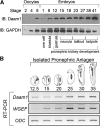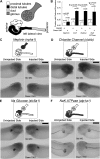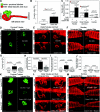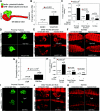Pronephric tubulogenesis requires Daam1-mediated planar cell polarity signaling
- PMID: 21804089
- PMCID: PMC3171937
- DOI: 10.1681/ASN.2010101086
Pronephric tubulogenesis requires Daam1-mediated planar cell polarity signaling
Abstract
Canonical β-catenin-mediated Wnt signaling is essential for the induction of nephron development. Noncanonical Wnt/planar cell polarity (PCP) pathways contribute to processes such as cell polarization and cytoskeletal modulation in several tissues. Although PCP components likely establish the plane of polarization in kidney tubulogenesis, whether PCP effectors directly modulate the actin cytoskeleton in tubulogenesis is unknown. Here, we investigated the roles of Wnt PCP components in cytoskeletal assembly during kidney tubule morphogenesis in Xenopus laevis and zebrafish. We found that during tubulogenesis, the developing pronephric anlagen expresses Daam1 and its interacting Rho-GEF (WGEF), which compose one PCP/noncanonical Wnt pathway branch. Knockdown of Daam1 resulted in reduced expression of late pronephric epithelial markers with no apparent effect upon early markers of patterning and determination. Inhibiting various points in the Daam1 signaling pathway significantly reduced pronephric tubulogenesis. These data indicate that pronephric tubulogenesis requires the Daam1/WGEF/Rho PCP pathway.
Figures





Comment in
-
Making a tubule the noncanonical way.J Am Soc Nephrol. 2011 Sep;22(9):1575-7. doi: 10.1681/ASN.2011070710. Epub 2011 Aug 11. J Am Soc Nephrol. 2011. PMID: 21836144 No abstract available.
Similar articles
-
Divergent roles of the Wnt/PCP Formin Daam1 in renal ciliogenesis.PLoS One. 2019 Aug 30;14(8):e0221698. doi: 10.1371/journal.pone.0221698. eCollection 2019. PLoS One. 2019. PMID: 31469868 Free PMC article.
-
Requirement of Wnt/beta-catenin signaling in pronephric kidney development.Mech Dev. 2009 Mar-Apr;126(3-4):142-59. doi: 10.1016/j.mod.2008.11.007. Epub 2008 Dec 7. Mech Dev. 2009. PMID: 19100832 Free PMC article.
-
Making a tubule the noncanonical way.J Am Soc Nephrol. 2011 Sep;22(9):1575-7. doi: 10.1681/ASN.2011070710. Epub 2011 Aug 11. J Am Soc Nephrol. 2011. PMID: 21836144 No abstract available.
-
Pronephric tubule formation in zebrafish: morphogenesis and migration.Pediatr Nephrol. 2017 Feb;32(2):211-216. doi: 10.1007/s00467-016-3353-1. Epub 2016 Mar 4. Pediatr Nephrol. 2017. PMID: 26942753 Review.
-
Noncanonical Wnt planar cell polarity signaling in lung development and disease.Biochem Soc Trans. 2020 Feb 28;48(1):231-243. doi: 10.1042/BST20190597. Biochem Soc Trans. 2020. PMID: 32096543 Free PMC article. Review.
Cited by
-
Coordination of kidney organogenesis by Wnt signaling.Pediatr Nephrol. 2014 Apr;29(4):737-44. doi: 10.1007/s00467-013-2733-z. Epub 2014 Jan 21. Pediatr Nephrol. 2014. PMID: 24445433 Free PMC article. Review.
-
Formins in Human Disease.Cells. 2021 Sep 27;10(10):2554. doi: 10.3390/cells10102554. Cells. 2021. PMID: 34685534 Free PMC article. Review.
-
Developmentally regulated GTP-binding protein 1 modulates ciliogenesis via an interaction with Dishevelled.J Cell Biol. 2019 Aug 5;218(8):2659-2676. doi: 10.1083/jcb.201811147. Epub 2019 Jul 3. J Cell Biol. 2019. PMID: 31270137 Free PMC article.
-
Wnt Signaling in Kidney Development and Disease.Prog Mol Biol Transl Sci. 2018 Jan;153:181-207. doi: 10.1016/bs.pmbts.2017.11.019. Epub 2017 Dec 30. Prog Mol Biol Transl Sci. 2018. PMID: 29389516 Free PMC article. Review.
-
Daam1 regulates fascin for actin assembly in mouse oocyte meiosis.Cell Cycle. 2017 Jul 18;16(14):1350-1356. doi: 10.1080/15384101.2017.1325045. Epub 2017 Jul 6. Cell Cycle. 2017. PMID: 28682694 Free PMC article.
References
-
- Park JS, Valerius MT, McMahon AP: Wnt/beta-catenin signaling regulates nephron induction during mouse kidney development. Development 134: 2533–2539, 2007 - PubMed
-
- Shu W, Jiang YQ, Lu MM, Morrisey EE: Wnt7b regulates mesenchymal proliferation and vascular development in the lung. Development 129: 4831–4842, 2002 - PubMed
-
- De Langhe SP, Sala FG, Del Moral PM, Fairbanks TJ, Yamada KM, Warburton D, Burns RC, Bellusci S: Dickkopf-1 (DKK1) reveals that fibronectin is a major target of Wnt signaling in branching morphogenesis of the mouse embryonic lung. Dev Biol 277: 316–331, 2005 - PubMed
Publication types
MeSH terms
Substances
Grants and funding
LinkOut - more resources
Full Text Sources
Other Literature Sources
Molecular Biology Databases

